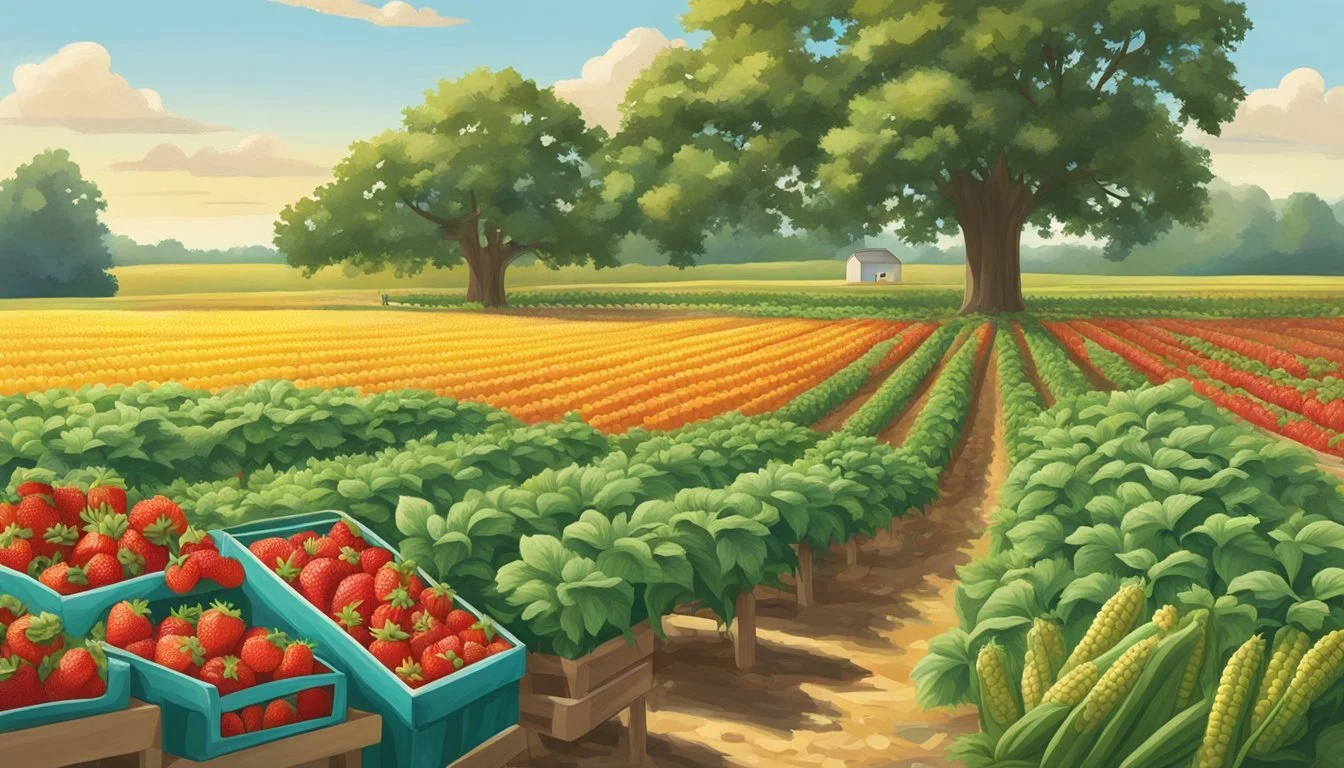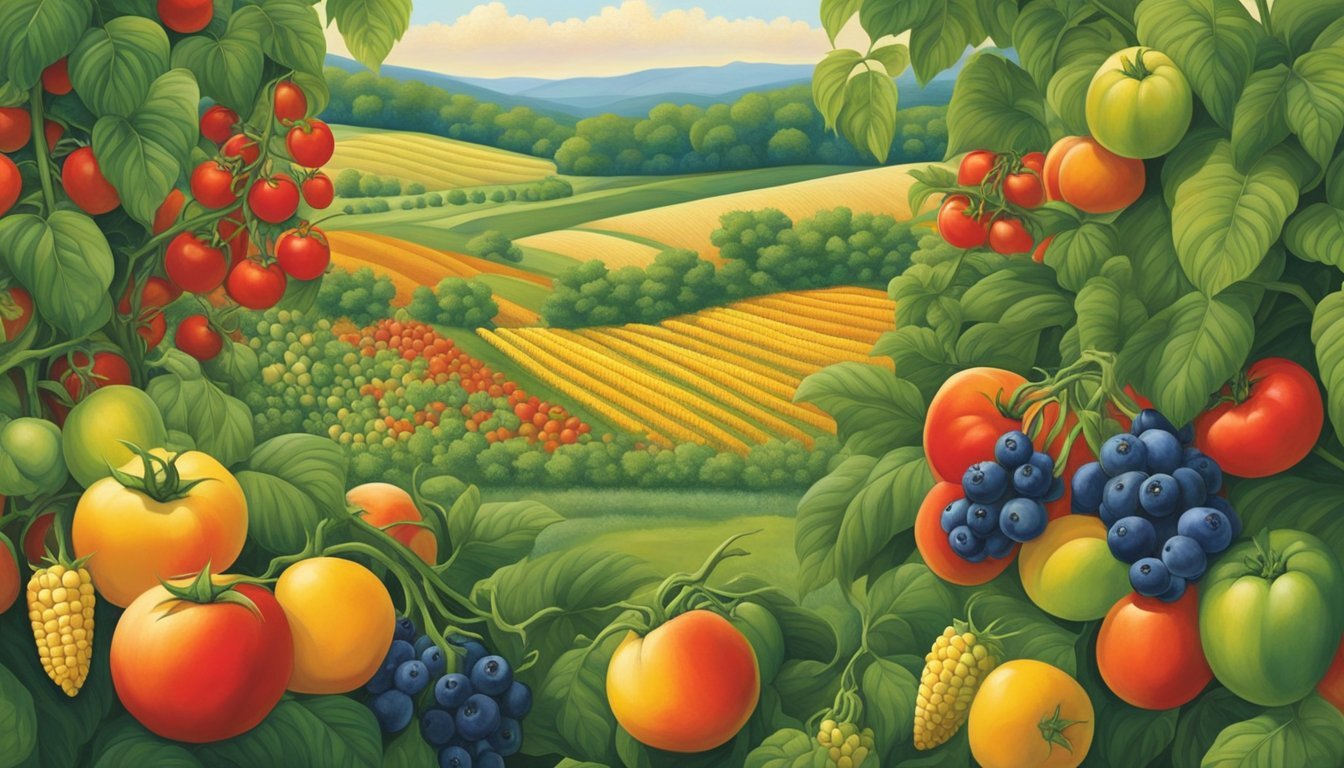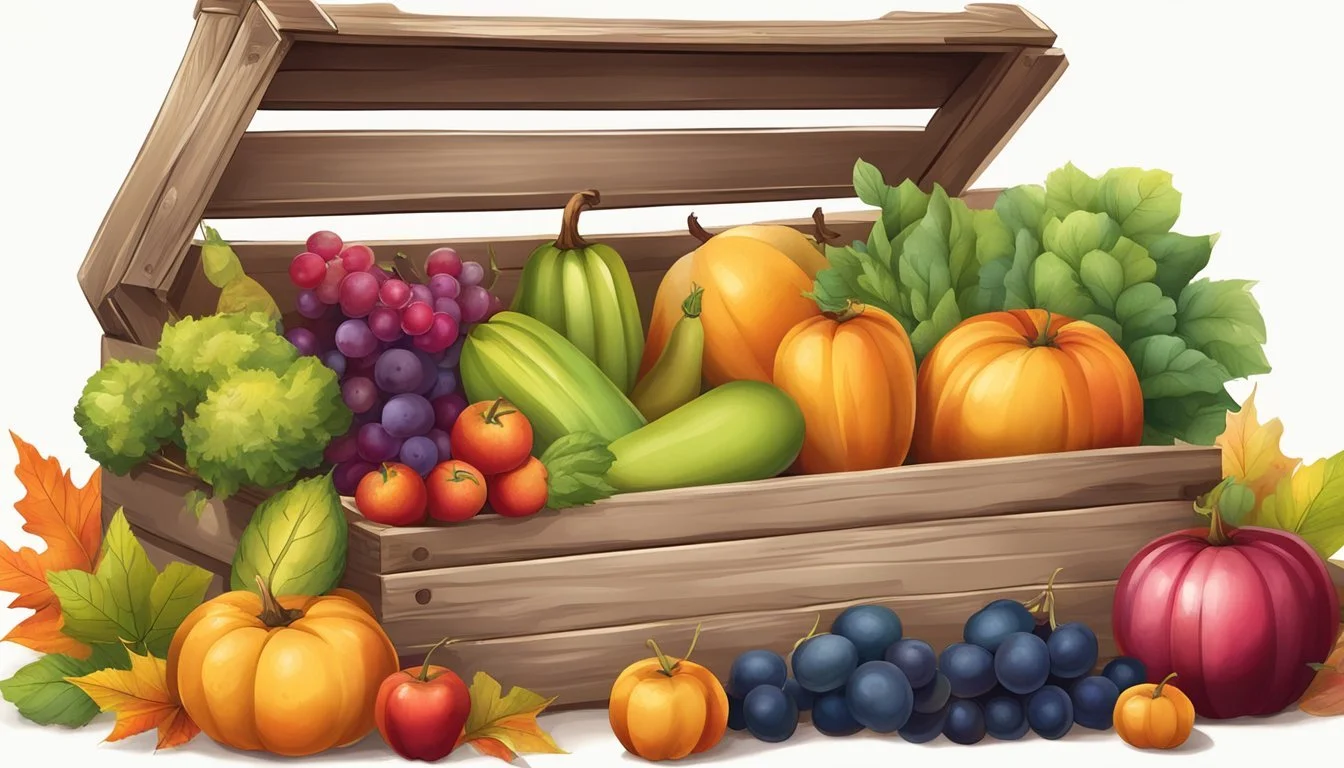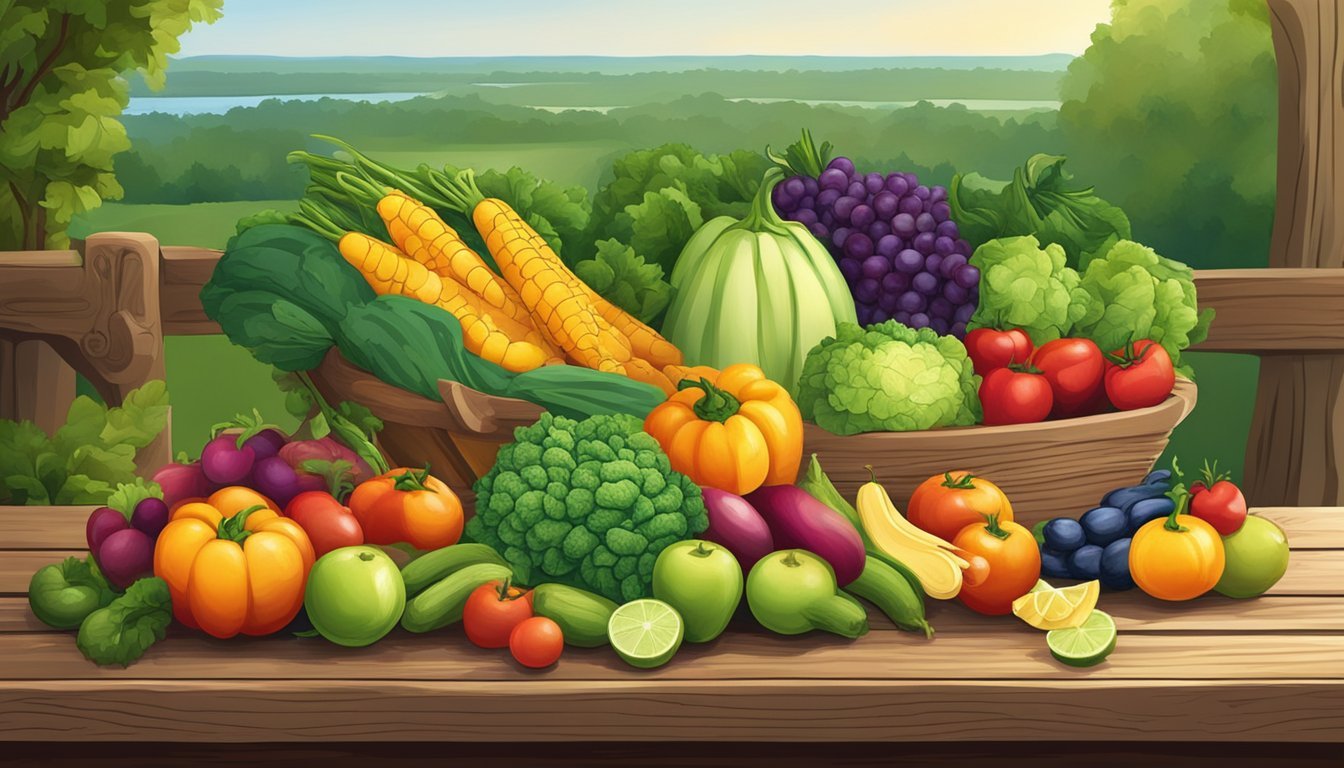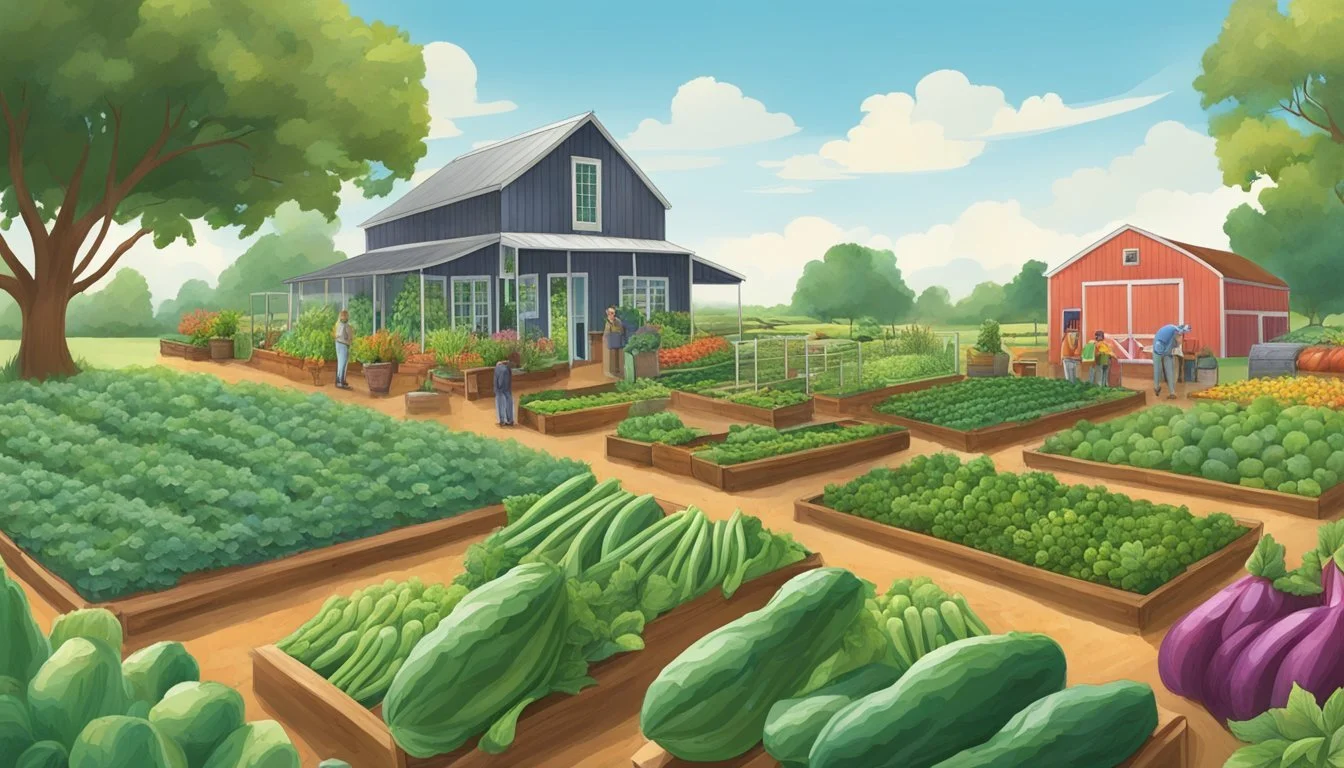Louisiana Seasonal Fruit & Veg Guide
Your Comprehensive Resource
Louisiana's agricultural landscape is as vibrant and diverse as its culture, offering a bounty of fruits and vegetables that vary by season. This seasonal flux is not just a matter of natural cycles, but also a testament to the state's commitment to farm-to-table principles, ensuring that locals and visitors alike can enjoy fresh, locally-sourced produce at its peak. With a climate that ranges from subtropical in the south to temperate in the north, Louisiana farmers navigate a unique growing environment to produce a variety of crops year-round.
The state's seasonal calendar informs consumers about the best times to purchase local produce, reflecting Louisiana's rich agricultural tradition and current farming practices. Staple crops such as sweet potatoes (What wine goes well with sweet potatoes?), rice, and sugarcane are complemented by an array of seasonal fruits and vegetables that come to market in a rhythmic succession. Summer brings succulent blueberries and juicy peaches, while cooler months see a range of leafy greens and root vegetables. The rhythm of the seasons is echoed in Louisiana's farmers markets, where each month offers a different selection, all grown within the state's fertile soil.
Understanding the seasonality of Louisiana's produce not only supports local agriculture but also promotes better health and nutrition through the consumption of fresh, nutrient-rich foods. This guide aims to navigate through the seasonal availability of Louisiana's fruits and vegetables, providing consumers with the knowledge to make informed choices that benefit both the local economy and their own well-being.
What’s in Season in Louisiana Right Now?
Understanding Louisiana's Seasonal Climates
In Louisiana, the climate varies significantly from north to south, affecting the seasonality of local produce. Understanding these regional differences is crucial for a Farm to Table guide.
Southern Louisiana Seasons
Southern Louisiana experiences a subtropical climate, characterized by hot summers and mild winters. Humidity is a constant presence, which can extend the growing seasons of certain fruits and vegetables.
Spring (March to May): Warm and wet, with increasing temperatures.
Summer (June to August): Very hot, often surpassing 90°F, with frequent thunderstorms.
Fall (September to November): Warm with less rainfall than summer.
Winter (December to February): The coolest season, rarely falling below freezing.
The following are typical of this region's harvest times:
Produce Spring Summer Fall Winter Strawberries Peak Available Tomatoes Peak Available Bell Peppers Peak Available
Northern Louisiana Seasons
Northern Louisiana's climate is more continental, with cooler temperatures and a shorter growing season than the southern part of the state. This results in a more traditional seasonal pattern.
Spring (March to May): Temperate and prone to severe weather, including tornadoes.
Summer (June to August): Hot, less humid than the south, with temperatures often above 90°F.
Fall (September to November): Cooler and drier, allowing for a crisp transition from summer heat.
Winter (December to February): The coldest season can feature frosts and occasional snow.
Key harvest times for this area typically include:
Produce Spring Summer Fall Winter Apples Peak Available Greens (Collard) Available Peak Available Peak Sweet Potatoes (What wine goes well with sweet potatoes?) Available Peak
Spring Harvest in Louisiana
With the arrival of spring, Louisiana’s farms commence the harvest of a variety of vegetables and berries. This is a time when freshness takes center stage at farmers markets, and the richness of Louisiana's soil is showcased through its produce.
March to May Vegetables
March April May Carrots Kale Green Beans Radishes Spinach Lettuce Herbs Spinach
Starting in March, the ground warms and yields early spring vegetables like carrots and radishes, which thrive in the cooler temperatures. Lettuce and spinach also make their appearance, bringing lush greenery to plates. As the season progresses into April, kale starts to flourish along with a mix of aromatic herbs. By May, gardeners and farmers are harvesting green beans among other tender, spring vegetables.
Berry Season Begins
Early Spring Late Spring Strawberries Blackberries (how long do blackberries last?)
Berry season launches in Louisiana as early as March with strawberries, a local favorite, hitting peak sweetness. These vibrant red berries are often celebrated with festivals and are prominent at local markets. Moving into late spring, as May approaches, blackberries begin to ripen, signaling the shift towards the heavier bounty of summer fruits.
Summer Abundance
As temperatures rise, Louisiana's farms teem with a diverse selection of fruits and vegetables. Mid-summer months offer the freshest flavors, with an impressive variety reaching its peak of ripeness.
June and July Harvest
During the early months of summer, the focus is on vibrant and fresh produce. They reap the rewards of corn, with its sweet and crunchy kernels, and cucumbers, perfect for cool salads or refreshing pickles. Tomatoes burst into the scene, varying from rich heirlooms to versatile Romas, each with its unique taste and texture. Peppers also start to make an appearance, ranging from sweet bell to fiery hot varieties, adding a pop of color and flavor to dishes.
Zucchini and eggplant (What wine goes well with eggplant?) are abundant, encouraging a host of recipes from grilled sides to hearty main courses. Fresh blackberries and blueberries become available, ideal for baking or as a natural sweetener in breakfast and desserts. The delicate fragrance of ripe peaches fills the air, signaling the perfect time for cobblers and jams.
Late Summer Crops
As summer progresses into its latter half, the heat-loving crops begin to take center stage. Cantaloupe (how long does cantaloupe last?) and watermelon grant a refreshing respite from the summer heat with their hydrating and sweet flavors. Orchards yield juicy peaches and pears, inviting one to indulge in home-made pies and preserves.
Okra flourishes in the Louisiana heat, becoming a staple in gumbo and stews. Rich, plump eggplant continues its season, alongside zucchini, which maintains its presence in the local markets. This is also the time for blackberries and blueberries to continue their season, being prime for picking and enjoying in their peak of natural sweetness.
Fall Flavors of Louisiana
In Louisiana, fall marks a transitional harvest period, where a variety of fruits and vegetables reach their peak, blending the end of summer freshness with the heartiness of the approaching winter.
Early Autumn Harvest
At the onset of autumn, Louisiana’s fields and orchards yield a diverse bounty. Squash varieties burgeon, offering a range of flavors and textures. Delicate figs start to make their appearance, adding a touch of sweetness to the fall palate. Beans and peas, staple crops, are gathered both for immediate consumption and for drying, to be enjoyed throughout the cooler months.
Grapes and tangerines also ripen, with vineyards and groves becoming places of busy activity as these fruits are picked at their juiciest. Here’s a brief overview of what to expect:
Squash: Butternut, Acorn, and others
Beans/Peas: Lima, Black-eyed, and others
Figs: Fresh and ready for various recipes
Grapes/Tangerines: Perfect for fresh eating or preserves
Thanksgiving Staples
Approaching Thanksgiving, Louisiana's tables boast a rich array of local produce. Plump pumpkins are ubiquitous, symbolizing the essence of fall and finding their way into both savory and sweet dishes. Sweet potatoes, a Southern favorite, are harvested in abundance and feature prominently in traditional Thanksgiving meals.
These staples are not only important for their cultural significance but also for their nutritional value, providing essential vitamins and fiber during the colder months. The typical Louisiana Thanksgiving produce includes:
Pumpkins: Ideal for pies, soups, and roasts
Sweet Potatoes: Versatile for casseroles, pies, and roasted side dishes
Wintertime Harvest and Planting
Louisiana's mild winters allow for a unique opportunity in gardening, where one can harvest and plant a variety of vegetables during the cooler months.
Late Winter Vegetables
Radishes thrive in the cool, moist conditions of a Louisiana winter. Practical spacing is crucial for their growth; gardeners are advised to plant radish seeds with sufficient room apart to promote optimal size and flavor. Collard greens are another robust winter vegetable, enduring frost and cooler temperatures with ease. These leafy greens can be harvested throughout the winter, offering nutrient-rich produce during a season when fresh options are valued.
It's important to remember that even though these vegetables can withstand mild winters, they still require proper care and consideration regarding soil, watering, and protection from pests for a successful yield.
Vegetable and Fruit Subgroups
In Louisiana, the fresh produce available can often be categorized into distinct subgroups: dark green, red/orange, and starchy vegetables. These subgroups are not only a way to organize produce by color but also by their nutrient profiles, which are important for a balanced diet.
Dark Green Vegetables
A variety of dark green vegetables flourish in Louisiana, providing a wealth of nutrients. Key vegetables in this category include:
Spinach: Packed with iron and calcium, spinach often peaks in freshness during the spring and fall.
Collards: These leafy greens are typically harvested in cooler months and are rich in vitamins A, C, and K.
Red/Orange Vegetables
Louisiana's red and orange vegetables are noteworthy for their vitamin A content. Examples from this subgroup include:
Sweet Potatoes: A year-round staple that is especially rich in beta-carotene and fiber.
Tomatoes: These can be found fresh in the summer and are a good source of vitamin C and lycopene.
Starchy Vegetables
Starchy vegetables are an excellent energy source and are featured prominently in Louisiana cuisine. In this category, you'll find:
Pumpkins: Available primarily in the fall, pumpkins are versatile and can be used in both savory and sweet dishes.
Corn: Sweet corn is a summer favorite, providing both fiber and B vitamins.
Tips for Creating a Louisiana Vegetable Garden
In Louisiana, the climate favors a year-round vegetable garden, allowing gardeners to continuously cultivate a variety of vegetables and fruits. For successful yields, understanding the local growing conditions is essential.
Location and Sunlight
A garden should be positioned in an area that receives six to eight hours of sunlight daily. Fruit-bearing plants, in particular, thrive in full sunlight.
Fruit-bearing crops: tomatoes, peppers, squash
Leafy vegetables: lettuce, broccoli, cabbage
Soil Preparation
Prior to planting, the soil must be properly prepared. Rich, well-drained soil supplements plant growth.
Test the soil to understand nutrient needs.
Aerating and enriching with compost enhances soil quality.
Planting Schedule
Louisiana's diverse seasons dictate planting times for various crops. A systematic planting schedule extends the harvest period.
Early May: corn, cucumber, beans, Swiss chard
June: cantaloupe, eggplant, okra, peppers, sweet potatoes
Water and Maintenance
Regular watering and maintenance ensure vegetable health, especially during Louisiana's hot summers. Adequate hydration keeps plants vigorous, while mulching conserves moisture and mitigates weeds.
Harvesting
Harvesting at peak ripeness maximizes flavor and nutritional content. Promptly removing spent crops and replanting maintains a productive garden cycle.
By adhering to these guidelines, gardeners can expect a bountiful, flavorful harvest from their Louisiana vegetable garden.
Farm to Table: Knowing Your Local Produce
Embracing a farm-to-table approach means cherishing Louisiana's seasonal harvests and directly supporting its farmers' toil. This approach encourages a deeper appreciation for the region's bounty and agricultural heritage.
Benefits of Eating Seasonally
In Louisiana, eating seasonally ensures the consumption of fruits and vegetables at their peak for flavor and nutritional value. Seasonal harvests correspond with the body's natural nutritional needs; citrus in winter provides Vitamin C, while summer fruits offer hydration. Fruits like watermelon and cantaloupe are perfect for cooling down in the Louisiana heat, and are best from late spring to early autumn, while vegetables such as sweet corn are summer staples, typically harvested from late May through August.
Supporting Louisiana's Agriculture
Fostering a connection with local agriculture is vital. When consumers purchase directly from Louisiana farmers, it bolsters the local economy and reduces environmental impact due to decreased transportation. The agricultural sector thrives on this support, sustaining a tradition of diverse crops. In the spring, options like fava beans (how long do fava beans last?) appear, available from February through May. Fall ushers in a time for root vegetables and hearty greens, with products such as collard greens available from October through June. Through thoughtful purchasing, residents play a crucial role in preserving Louisiana's rich agricultural landscape.

